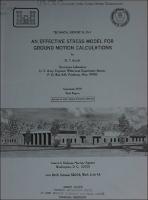Please use this identifier to cite or link to this item:
https://hdl.handle.net/11681/11281| Title: | An effective stress model for ground motion calculations |
| Authors: | United States. Defense Nuclear Agency Baladi, George Y. |
| Keywords: | Constitutive models Ground motion Ground shock Stress-strain relations Strains Stresses Shock waves Mathematical models Numerical models |
| Publisher: | Structures Laboratory (U.S.) Engineer Research and Development Center (U.S.) |
| Series/Report no.: | Technical report (U.S. Army Engineer Waterways Experiment Station) ; SL-79-7. |
| Description: | Technical Report Abstract: This report documents the development of a three-dimensional, elastic-plastic, work-hardening constitutive model based on the theory of effective (intergranular) stress for the purpose of simulating the response of isotropic three-phase (partially saturated) earth materials. This model can be used to perform effective stress ground shock analyses. The model is actually a marriage of two single-phase elastic-plastic models which simulate, respectively, the drained and undrained stress-strain behavior of earth media, and whose coefficients can all be determined experimentally using conventional laboratory testing techniques. Fitting the model, therefore, requires an extra set of laboratory tests (the drained tests) over that required to fit a contemporary (total stress) ground shock model. For undrained applications (where only the applied total stresses are usually known), the model predicts total stresses and ground deformations as well as the effective stresses and pore pressures. Pore pressure is an output from the model, not an input. Laboratory pore pressure data obtained during conduct of the undrained tests, however, are extremely useful for verification of the model. The model is examined under simulated drained and undrained laboratory test conditions to depict its various features and illustrate the techniques for fitting its functional coefficients. In addition, given a set of stress increments or a set of strain increments, two general methods are presented for exercising the model to compute the resultant total stresses, effective stresses, pore pressures, and deformations. The feasibility of using the new model for effective stress ground shock analyses is demonstrated numerically by solving a simplified two- dimensional airslap problem for a saturated sand halfspace using an effective stress version of the LAYER code. The real power of this computational tool has yet to be investigated by applications against actual field experiments. Appendix A reviews the fundamentals of elastic-plastic models. |
| Rights: | Approved for public release; distribution is unlimited. |
| URI: | http://hdl.handle.net/11681/11281 |
| Appears in Collections: | Technical Report |
Files in This Item:
| File | Description | Size | Format | |
|---|---|---|---|---|
| TR-SL-79-7.pdf | 14.49 MB | Adobe PDF |  View/Open |